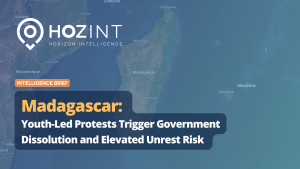Key points
-
Rapid Support Forces (RSF) seized El Fasher after an extended siege, including the army’s Sixth Infantry base; international outlets and the UN reported large numbers of civilian deaths during and after the takeover.
-
Health-facility killings: WHO reports >460 patients/companions killed and six health workers abducted on 28 Oct at the Saudi Maternity Hospital.
-
Population movement: IOM documented rapid displacement toward Tawila within 48 hours of the assault.
-
International response: The UN Security Council and AU Peace & Security Council issued statements condemning the violence and urging protection measures.
Event description
What: RSF forces captured El Fasher, North Darfur’s capital, after breaching key defensive positions and entering urban districts; reports describe large numbers of civilian deaths, detentions, and raids at medical sites, including the incident at the Saudi Maternity Hospital.
Who: RSF and allied fighters versus Sudanese Armed Forces and local aligned elements; international organisations (WHO, IOM, UN) and multiple media corroborated significant civilian impact.
When: Main assault and consolidation 26–31 Oct 2025; hospital incident 28 Oct.
Where: Across El Fasher—including the Sixth Infantry base, displacement sites, and medical facilities—with outward movement toward Tawila.
How: Encirclement followed by multi-axis ground advances, use of drones and indirect fire during the siege and assault phase, then street-level sweeps and checkpoint control.
Why: Control of El Fasher strengthens RSF’s position across Darfur and may reinforce an emerging east–west division of Sudan, enabling redeployment to other fronts.

Analysis
Independent reporting indicates that, following months of siege conditions, RSF breached the army’s headquarters and moved to secure central nodes, accelerating the collapse of organised resistance within the city. Communications outages complicated situational awareness, but core facts—loss of the Sixth Infantry base and RSF presence across districts—are consistently reported.
The health-facility incident is especially consequential for operational planning. WHO’s 29 Oct statement cites more than 460 patients/companions killed at the Saudi Maternity Hospital and six health workers abducted the day prior. This indicates that medical facilities cannot be assumed to provide protection and that medical evacuation/trauma care capacity is severely constrained.
Civilian movement patterns show a rapid outflow toward Tawila immediately after the city’s fall, with humanitarian snapshots and IOM noting displacement within 26–29 Oct. Route conditions remain fluid; some accounts describe shootings and detentions of men attempting to flee, underscoring interception risk along exit corridors.
At the strategic level, we assess that control of El Fasher could entrench a geographic split and free RSF resources for operations beyond Darfur. The UN Security Council and AU PSC have publicly pressed for protection of civilians and accountability measures, but the immediate deterrent impact is uncertain absent enforceable constraints on supply lines and weapons flows.
Disruptions & travel advice
-
Security posture: Threat level Extreme; the operating environment is non-permissive. Armed checkpoints, house-to-house searches, and detentions have been reported; sporadic fire may continue. Avoid all non-essential travel.
-
Movement: Overland routes toward Tawila/Mellit face sudden closures and interception risk. If movement is unavoidable, use low-profile conveyance, varied routing, and rapid-execution plans; pre-stage supplies and maintain trusted local liaison.
-
Medical: Assume severely degraded clinical capacity in El Fasher. Do not rely on hospitals for refuge; coordinate any medical moves through vetted channels only.
-
Aviation: Expect denial of airstrip use and airspace hazards; prior drone/indirect-fire use near civilian sites indicates elevated risk to low-altitude aircraft. Launches should occur only with same-day validation and formal deconfliction.
-
Operations: Suspend non-essential presence; use remote management. For essential life-saving tasks, ensure hardened shelter, 72–96h sustainment stocks, redundant comms (satellite + HF/VHF), and contingency for detention/route blockage.
Forecast (4–12 weeks)
-
Control & security: RSF is likely to consolidate control in El Fasher and adjacent localities; reports of killings and detentions during flight suggest continued risk to civilians and personnel outside secure compounds.
-
Counteraction: SAF may attempt standoff strikes where feasible; a large counter-offensive in North Darfur appears unlikely in the near term.
-
Humanitarian outlook: Additional displacement toward Tawila and potential cross-border pressure into Chad; disease risks rise as WASH and care capacity remain constrained. Access will depend on permissions and security guarantees.
-
Diplomacy: Continued UNSC/AU engagement; effectiveness hinges on practical enforcement (e.g., monitored access, arms interdiction, targeted sanctions).



